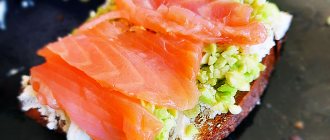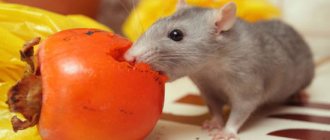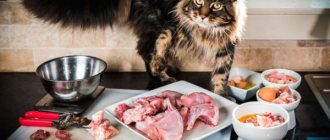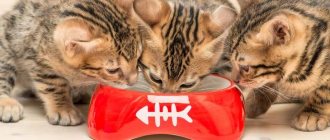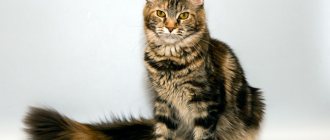Why do animals get sick? Everyone is accustomed to “dumping” responsibility on the selection and “translation” of the breed, on “illiterate” doctors, on “amateur breeders” - there is some truth in this. People blame everyone around them, trying to justify themselves, because the owners are most often to blame for pet illnesses. The main risk factor is improper feeding and violation of maintenance standards; every breeder should know what not to feed cats and how to create a diet for an animal with special needs.
The role of meat in the diet
First, let's figure out why this product is so important.
Cats are obligate (unconditional) predators. It is animal protein that forms the basis of their diet in the wild. At the same time, all parts of the prey are eaten: the meat itself, internal organs, skin, and cartilage. From such foods, cats receive energy and all the necessary nutrients, including taurine, the most important amino acid for them.
A lack of taurine leads to hair loss and a sharp deterioration in the structure of the coat, loss of vision, impaired blood supply to the heart and liver, obesity, infertility, and in pregnant females – to miscarriages.
Plant proteins are digested by cats much less well and put a slightly greater burden on the kidneys. They do not contain taurine. Thus, although vegetables and greens are beneficial for cats in small quantities, they cannot replace meat.
Biologically appropriate nutrition is not just about fillets
In their natural habitat, predators do not cut up the carcass of a caught prey, but eat it entirely fresh. Muscle meat provides the body with the necessary amino acids, liver, kidneys and stomach - vitamins and minerals, cartilage - collagen for healthy joints, bones - calcium and phosphorus. All this is present in biologically appropriate feeds created according to the WholePrey principle (translated from English as “whole prey”).
Fillet purchased in a store or market will be complete food for a cat in terms of amino acid composition, but the intake of the remaining nutrients discussed above into the body will remain a big question. If you use boiled fillet, there will be even less nutrients left in it. Thus, by combining dry food and meat in a cat’s diet, we risk depleting its diet, which over time can cause disruptions in the body’s functioning. Vitamin and mineral supplements may be needed to correct the deficiency.
Why cats should not be given pork
This product was “rejected” completely undeservedly. There is no reason - someone somewhere heard that cats should not eat pork. Don't be surprised: those premium products that you buy for your pets with such trepidation contain a sufficient amount of pork and pork by-products. Those interested can check the portal www.feline-nutrition.org - everything is eloquently described there.
Does this mean that pork meat can become the basis of your pet’s diet? Certainly not. Likewise, there are no contraindications to adding the product to the main diet.
We also caution you to add ham and other corned meat to your pet's food. No, not at all because of the fatty pork. Sodium is actively used in the preparation of ham and other meat delicacies. A slice of ham eaten by a cat automatically means that the cat’s daily needs for this chemical element are covered six times.
General Safety Tips
You can't tell if your pork is infested with Trichinella or pork tapeworms just by looking at it because these larvae are microscopic in size. Therefore, the best protection against trichinosis is thorough cooking of pork.
Trichinella die at a temperature of 58°C, and tapeworm eggs and larvae die at a temperature of 50–65°C (5, 8, 9).
One study found that pork tapeworm eggs and larvae can be killed at a lower temperature of 50°C in roasts that bake for 15 to 20 minutes, but higher temperatures of over 65°C are required when cooking ground pork dishes (8, 9).
Experts recommend cooking pork until its internal temperature reaches 63°C when cooking chops, steaks and pork tenderloin. Cook ground pork, processed meats, or mixtures until an internal temperature reaches at least 71°C (10°F) (10).
Whether it's pork or minced meat, you should let the meat rest for 3 minutes before eating it. This allows the meat to continue to cook and raise the temperature.
When cooked to 63°C, you may notice that white meat has a pink tint when you cut into it. According to revised USDA guidelines, this is acceptable.
To measure the temperature of your meat you must use a calibrated thermometer and follow the manufacturer's recommendations.
Proper food processing is also very important. This means that hand washing is a must when preparing food, as is using clean drinking water to wash surfaces, utensils or utensils.
Conclusion:
Cooking pork to a safe temperature is essential to avoid contamination. Although pork tenderloin, chops and steaks should be cooked to 63°C, ground pork should reach at least 71°C. Let the meat rest for 3 minutes before eating.
Why is the raw product dangerous?
Cats digest raw meat best, but there are two dangers when consuming it:
- Worms. The meat may contain helminth eggs. These parasites poison the animal’s body, often damaging its internal organs, and if severely infested, lead to intestinal blockage. Without timely treatment, the cat may even die.
- Bacterial infections. If meat is sold from an open market stall, flies may land on it and carry the disease. Shopping in such places should be avoided so as not to harm your pet.
Why is pork banned?
Any sane person understands that prohibitions do not appear out of nowhere. Pork is no exception; the bad reputation of this product, unfortunately, was justified by facts. There is no need to be afraid, since all threats can be avoided with a reasonable approach and sufficient awareness.
Never buy meat (any kind) at spontaneous markets. For some reason, people get the impression that if it’s bought secondhand, it means it’s homemade and of high quality. In fact, spontaneous traders very often neglect the standards for raising animals, vaccinations, and requirements for storing meat. Particularly enterprising traders buy carcasses from industrial farms and sell them as domestic ones.
Supermarkets often resort to tricks to make stale meat look fresh. For example, meat is dyed after being kept in a saline solution. After processing, the products look lush, heavy, beautiful... and inviting, despite the significant delay. You may come across promotions such as pork marinated or packed in sealed bags. Don't give in! The marinade helps eliminate the smell of rot! A sealed bag is a way to hide odor and compress meat to give it a more marketable appearance. Please note that lost meat in a vacuum is a rich and very fertile breeding ground for all possible bacteria.
What to do before serving
There are three main ways to secure meat:
- Cooking. In this case, the meat is boiled for about 5 minutes.
- Scalding small pieces with boiling water.
- Deep freeze. The only way that allows you to leave the meat raw. To do this, cut it into pieces and place it in the freezer for 4–5 days (at least 48 hours). The helminth eggs die. The pieces do not need to be made too small: when a cat bites off and gnaws food, it simultaneously produces gastric juice. The meat is cut finely (about 1.5x1.5 cm) only for those animals that in a hurry swallow it almost whole.
What kind of meat should I give - raw or cooked?
The product contains the most B vitamins compared to other types. It also contains a lot of zinc, magnesium, potassium, iron and other useful trace elements. All these substances are necessary for both cats and dogs so that their health does not deteriorate.
You can give your cat raw pork from time to time. This is how nature decided that all felines are predators. But in the wild or just on the street, no one prepares prey for them. The digestive system is designed to digest raw food.
The nuance is that there is a difference between a domestic cat and a wild or street cat. If a pet has eaten only store-bought food since birth, its gastrointestinal tract has developed in its own way and will have difficulty digesting the raw product and killing harmful bacteria.
Therefore, you should start from the situation. If your pet has always eaten raw meat, you can sometimes put it in a bowl. But for chronic diseases, especially in the esophagus, it is better to refuse such feeding.
Is it possible to give a cooked product?
After heat treatment, not only harmful but also beneficial substances are destroyed in any food. During cooking, up to 70% of thiamine and taurine are lost, and the protein is denatured. As a result, the digestion of boiled pork is complicated, because natural enzymes also disappear.
In general, there is no harm from the boiled product for a healthy pet. This product can be given from time to time. But one thing that is definitely forbidden is boiled bones. After heat treatment, they become insoluble and sharp, which can have dangerous consequences for the gastrointestinal tract.
Mixed nutrition
There are three types of diet for domestic cats:
- natural nutrition from ordinary products familiar to humans;
- feeding with ready-made industrial feed created for animals;
- mixed diet, which involves feeding cats natural products in combination with ready-made food.
Natural food and raw meat
When feeding natural food, the issue with raw meat is resolved on its own. This product is included in the pet menu. It can be served in processed form. To get a more nutritious meal, veterinarians recommend combining meat pieces with other healthy foods.
Dry, wet food and raw meat
Is it necessary to feed a cat raw meat if it regularly eats ready-made industrial food?
Many experts do not recommend combining ready-made food with natural food, believing that such a composition will only cause harm to the animal’s body. Others recognize the possibility of mixed nutrition, but on the condition that an interval of several hours is maintained between feeding food and natural food. During this time, the cat’s body will have time to digest the previously consumed product.
If your cat eats premium wet food, it is not necessary to add raw meat to the menu. High-quality feed contains natural meat, so there is no need for additional complementary feeding with this product.
Which types to give preference to?
A cat's diet can be combined from several types of meat products:
- Lean beef. Contains a large amount of protein, moderate amount of fat, rich in taurine. It is believed that this meat brings the greatest benefit to the cat’s body. It can be given to your pet every day.
- Mutton. Only lean pieces. Can be given every day.
- Rabbit meat. Contains less protein and fat than beef. Recommended for cats that are overweight or have kidney failure.
- Turkey meat. Rich in protein and lean meat. It is advisable to alternate with beef.
- Chicken. Chicken meat is easily digestible, suitable for dietary nutrition, and contains a lot of protein. A number of experts, however, are wary of it because of modern methods of raising chickens (the use of hormonal supplements, antibiotics by producers, feeding salt before slaughter, etc.). Like turkey meat, you can give it from time to time.
- Fish. Only sea and boiled. No more than 200 g per week is allowed.
- Offal. The hearts can be chicken or turkey. Beef liver, lungs or tripe are preferred. By-products must be present in the diet, but not more than 200 g per week. Liver is given especially carefully: raw liver relaxes the intestines, and boiled liver strengthens it.
- Chicken necks without skin. They contain a lot of calcium, which other types of meat products are poor in. Some advise turning them through a meat grinder or beating them with a hammer, others recommend giving them whole. Focus on the capabilities of the pet itself: a kitten may not chew its neck, but a large cat can handle it easily. 3-4 raw shakes per week are allowed.
- Chicken heads. The most controversial product. The brain they contain is certainly beneficial for pets, but small bones, according to some veterinarians, can clog or injure the intestines. Other experts insist that chicken heads are essentially “mice” for cats, which these predators eat whole, and that the thin bones of the skull are easily digested. One way or another, no more than 2-3 goals per week are allowed. Please consult your veterinarian before adding this product to your pet's diet. Please also keep in mind that this is rough food, and it can really cause harm to a cat who has lived for years on soft, easily digestible food.
Now let's find out what types of meat should not be fed to cats, even in small quantities. These include:
- pork;
- fatty lamb;
- fatty poultry (geese and ducks);
- chicken skin;
- purchased minced meat (their composition may be far from what is stated);
- large and tubular bones - they injure and clog the esophagus;
- any fried, smoked and salted meat;
- canned food and sausages.
Some owners wonder why cats should not be given pork, such as lean parts of the carcass. The fact is that this meat often causes intestinal upset in pets.
Fish
Arguments why you can’t feed a cat fish are divided into three main types: about dangerous fish bones, then about infection with helminths, and the last one is metabolic disorders. On the one hand, everything is reasonable, but on the other hand, many cats literally pounce on fish and eat it with pleasure due to a lack of protein.
- Avoid freshwater fish - there is little benefit, and the risk of helminth infection is high.
- Ocean fish contains fatty amino acids, but it is not recommended to give it often - 1-2 times a week.
- Feed only thoroughly cleaned and cooked fish.
- Use fish as an additive to your main feed.
- It is not recommended to feed a cat fish after castration; a large amount of phosphorus can provoke the development of urolithiasis.
Harm and benefit for cats
There is an opinion that this product is dangerous for pets. Pork should not be introduced into the diet of animals for several reasons:
- It is considered one of the fattest types of meat, and fatty foods are strictly prohibited for cats.
- Pork is difficult to digest and can disrupt the digestive system.
- Insufficient amount of protein and amino acids in the composition.
Sterilized and neutered cats should not be given pork. This is due to a sedentary lifestyle and the threat of obesity.
However, there are also positive qualities of pork meat. For example, the product contains a huge amount of B vitamins, which makes it possible to maintain the body’s energy balance. The meat also includes:
This product contains a lot of lysine, which is beneficial for the musculoskeletal system of the animal.
- Calcium and magnesium. Have a good effect on the cardiovascular system.
- Lysine. Correctly forms the joints and skeletal system.
- Iron. Enriches cells with oxygen.
- Zinc. Supports immunity.
Cheese-related products
Having heard the term, a person imagines a yellow dense piece with holes. But cheese is called different products. In English the word additionally means:
Cats like all these dishes. Breed does not affect preference. Elite pets and yard dwellers show interest in cheeses. Animals can literally snatch a milk-coated sandwich from a person. The decision to share with your pet depends on the composition of the product.
Potentially Hazardous Components
Cats and people perceive biological substances differently. Onions (tuber and stems) and garlic are dangerous foods that can cause the breakdown of red blood cells. Not found in regular cheeses, they are potential additives for brushes, processed foods, and pet-attracting flavorings.
Other potentially hazardous ingredients include:
Mold – you should not give elite cheese to cats. Microorganisms can disrupt the bacterial balance of the intestines. A product that has become more expensive in the refrigerator should not be eaten by the animal or its owner.
Dyes. Stores offer colorful cheeses, colored by natural additives: tomatoes, lavender, herbs. Natural and synthetic pigments are potentially dangerous for cats. Natural dyes will provide a rich shade due to their high concentration. Spices and nightshades (tomatoes) are potential toxins for cats. Synthetic pigments tend to accumulate in the body, affecting the functions of internal organs.
Flavorings, taste enhancers. They are addictive, can cause allergies and other unpleasant consequences.
Homemade dairy products pose additional risks. Raw cottage cheese (cheese cheese) may contain pathogens, manufacturer. Having caused indigestion in a person, it can cause serious poisoning and damage to internal organs in a pet.
So can cats have cheese?
The diet of animals was formed in ancient times. The cat's diet is based on animal proteins and fats. Modern feeds take this need into account. Although veterinarians recommend sticking to a single diet (dry foods or natural), you can combine prepared foods with reward treats. Cheese is one of the rewards.
Best articles: Which spider is the most poisonous on Earth - photos and descriptions of the most dangerous species of spiders
Products from this group are popular with many mouse catchers. When deciding whether cats can have cheese, it is worth finding out about their lactose sensitivity. Animals' bodies produce few enzymes that break down cow's milk, the main ingredient in cheeses. Nature did not provide for its perception in cats.
Pets love dairy products - a source of fats and proteins. But the substances coming from the cow are poorly absorbed. Humans also have problems.
Lactose-free products are suitable for cats. Manufacturers offer cheeses and paste-like masses that do not contain an unpleasant substance. For their production, soybeans and other organic raw materials are used.
Cats can better tolerate goat, sheep, and other milk products
When choosing cheese with a minimum of lactose, you should pay attention to:. These products can be given to cats as treats, rewards (up to 1-5 g per day)
Spreads will be an additional reward. Their consumption should be limited due to the abundance of preservatives and flavorings
These products can be given to cats as treats and rewards (up to 1-5 g per day). Spreads will be an additional reward. Their consumption should be limited due to the abundance of preservatives and flavorings.
Cottage cheese and feta cheese are given to pets from trusted manufacturers. You should not offer animals unknown products without heat treatment.
Cats can eat cheese. It is not included in the main diet, but animals like it because of its composition: proteins, fats, flavors. It is better to offer your pets natural products. Cats love feta cheese, cottage cheese, and their derivatives belonging to the “cheese” category.
Such products are given to animals from trusted suppliers. Industrially produced cheese should not contain mold, spices, or large amounts of lactose.
Cats can be given different types of dairy products, observing their reaction. So the owner will choose the optimal additions to the diet.
https://natworld.info/domashnii-zhivotnye/mozhno-li-davat-koshkam-syrhttps://koshek.ru/mozhno-li-koshke-davat-syir.htmlhttps://lovecats.ru/mozhno-li- koshkam-syr/
The main dangers of pork
What dangers could your cat face when consuming this meat product? There are problems, and serious ones. Unfortunately, pigs themselves are susceptible to many dangerous diseases. In order to get sick, your pet only needs to eat raw meat from a sick animal.
Pork is quite a fatty product, this should also be kept in mind. Finally, many cats are diagnosed with individual intolerance to pork and experience allergic reactions.
Trichinosis
As for trichinosis, it is a very dangerous infectious disease. Infection mainly occurs through eating raw meat. In the last century, this was a real scourge for both farmers and veterinary services. Thank God, thanks to the effective system of measures adopted, the risk of purchasing contaminated meat is minimal. If you want to treat your pet to raw pork, purchase products intended for human consumption and only from trusted places. Never experiment with game - wild boar, elk, bear meat, etc.
Doctors say that trichinosis can be treated well with the same medications as roundworms. True, Trichinella larvae, which find refuge in muscle tissue, pose some danger.
Trichinella is spread by mice and rats. Be careful if your cat hunts rodents on the street, much less eats them. Then you will wonder for a long time where your pet contracted trichinosis.
Trichinosis
Separately, it is worth mentioning trichinosis. This disease is considered one of the most dangerous. However, everything is complicated by the fact that the pathology is difficult to recognize. Often the diagnosis is made at a late stage, when the cat can no longer be helped or after its death.
The survivability of the larvae directly depends on the duration of infection. If they were encapsulated in meat or muscles, then they are not afraid of either boiling water or cold. As soon as the larvae enter the cat’s body, they will immediately burst and infection will begin. Trichylella live in the intestines for 45-60 days.
Then they move into the muscles, where they exist for years. This foreign invasion can cause cats :
- swelling;
- muscle pain;
- skin rashes;
- diarrhea;
- a sharp increase in temperature;
- changes and blood diseases.
Pork can be completely excluded from your cat’s diet. Otherwise, eating this type of meat can lead to kidney failure, liver cirrhosis, and pancreatitis. Pork can cause allergies and cardiovascular diseases. When purchasing offal, you need to look at the composition. Sometimes, in order not to indicate that it contains pork,...
Giving pork to cats, even boiled pork and even in small quantities, is also not recommended. Despite the fact that food in this form is well absorbed, there is still a risk of liver cirrhosis, pancreatitis, and chronic indigestion.
However, if the owners still decide to add pork to the cat’s food, then veterinarians advise buying only shoulder, heart or tenderloin, and completely free of fat.
Combination nuances
As you can see, both raw and cooked meat are allowed in the diet of cats. The main thing is not to mix them in one feeding, since digesting the product in one form or another requires different enzymes from the gastric juice. When they are released at the same time, digestion becomes worse.
Carefully choose meat, try to maintain a balance of products, do not forget about freezing, and your cat will delight you with beauty, activity and health for a long time.
Why do animals get sick? Everyone is accustomed to “dumping” responsibility on the selection and “translation” of the breed, on “illiterate” doctors, on “amateur breeders” - there is some truth in this. People blame everyone around them, trying to justify themselves, because the owners are most often to blame for pet illnesses. The main risk factor is improper feeding and violation of maintenance standards; every breeder should know what not to feed cats and how to create a diet for an animal with special needs.
Advertising, the “war” of industrial giants, rumors that have turned into “breeder experience” distort the true state of affairs so much that even professional veterinarians promote “taboos” imposed by society. Let's look at the list of main prohibitions and the arguments behind them.
Rules for eating pork during lactation
To avoid negative consequences, mother should adhere to some recommendations when eating pork:
- Pig meat should be introduced into the diet no earlier than 90 days after delivery. You should start with broth made from lean pork, you can add vegetables. The broth must be secondary, in which case the content of harmful substances in it is minimal. Over the next two days, observe the baby's reaction. If there is no bad reaction to the soup, you can try introducing meat, starting with 50 grams. If a child experiences an upset stomach or an allergic reaction, then attempting to eat pork should be postponed for a month;
- A nursing woman can consume pork no more than once every 7 days. You are allowed to eat 100–150 grams of pork per day;
- It is recommended to eat pork before lunch;
- For nutrition, you should choose lean pieces of meat. Lard should make up less than 10% of the total share;
- Before cooking, the meat must be thoroughly washed and excess fat trimmed off;
- It is forbidden to eat raw meat or food streaked with blood;
- the product must be subjected to long-term heat treatment;
- the best option for a nursing mother would be steamed pork, baked, boiled or stewed meat;
- fried, smoked, and grilled pork should be limited;
- During lactation, you can eat pork liver, which is well digestible and contains a little fat.
You should start introducing pork into your diet with broth.
Breed exceptions
What cereals can be given to dogs: is it possible to give porridge?
Can a Spitz eat pork? The answer to such a question will be negative. For small dogs such as Chihuahuas, Spitz, and Toy Terriers, fatty foods are contraindicated. In particular, due to the fact that these breeds are prone to obesity.
As for larger dogs, such as a shepherd, husky, or alabai, a small amount of pork in the diet will not cause harm. However, under no circumstances should you feed your animal raw meat.
Everything is good in moderation
What parts of pork carcass can be included in the diet?
The owner who decides to give his pet pork should know that the diet can include:
- ham meat;
- tails;
- snouts.
Pork heart for dogs is also an acceptable option. As for bones, they should be given out with great care. Ribs are not recommended for small breeds.
Another important question: is it possible to give lard or skin to a dog? In this case, there are no prohibitions, but it is best to limit yourself to the smallest amount. The skin is not a nutritious product, and lard is high in calories and has a minimal set of beneficial properties.
Can dogs have boiled pork?
For healthy animals, this type of boiled meat is not contraindicated. Especially if the meat component is pre-mixed with boiled potatoes or porridge. In this case, you will get a nutritious and healthy dish.
On the other hand, you should refrain from adding boiled meat to the diet or do it with extreme caution if your pet suffers from liver disease, spleen disease, tumors or hepatitis. It is worth noting that such ailments, in principle, require adherence to a strict diet, which does not include pork.
Balanced cat diet
It is better to buy any meat in a store, and not at the market from random sellers. In a specialized department, before sale, it is checked by sanitary and veterinary inspections, and is also properly stored and transported.
To prevent the formation of bacteria, it is worth defrosting the product in the microwave or refrigerator.
To provide a balanced diet for cats with pork, it is best to cook it. The process should not be long - no more than 5 minutes. It is also possible to bake in foil to prevent a crust from appearing.
But the main thing is to feed the animal in addition to meat products in a varied and balanced manner, including vegetables and fruits, so that the body does not experience a shortage of certain substances.
Many people have strong prejudices about the process of raising pigs and, in particular, the lifestyle of these animals. They say they love to wallow in the dirt and generally feed on food waste. So what? It turns out that this product simply has to absorb street dirt? Of course not. It's a delusion.
If, due to religious beliefs, you refrain from eating this type of meat product, then it would be logical if your pet does not eat such food either.
Pork is not a vital food for cats. If you want to treat your pet to meat, there is beef, lamb, chicken, etc. But remember: this type of food will be an excellent addition to your pet’s main diet. There are no contraindications.
Standard cat diet
Everyone knows that cats are carnivorous animals, that is, it is normal for them to eat meat. In nature, animals do not prepare their own food, they eat what they managed to catch along with wool, bones and entrails. If we are guided by this argument, then all the rules for keeping pets will lose their relevance.
The truth is that our domestic cats have long moved away from wild ways of life, although they have retained excellent hunting skills. As before, tailed animals need meat, but in addition to it, cats can receive a number of varied, tasty foods, vitamin supplements, treats and industrial food.
Industrial diet
Let's briefly look at industrial feeds. The option preferred by many is “drying”. There is no doubt about it, dry food is convenient, easy to store, dose, and most importantly, there is no need to prepare it. In addition to drying, manufacturers offer semi-moist food and canned food that can diversify your pet’s diet.
When choosing food, it is important to understand that products are divided into classes:
• Economy is the cheapest food, not recommended for daily use.
• Premium and super-premium – the middle price segment for everyday feeding.
• Holistic – special or medicinal foods used for urolithiasis (urolithiasis), food allergies and other ailments.
The choice of brand, line and type of product is an individual matter. Naturally, it is better to focus on manufacturers with a good reputation and products of original quality. What you should not do is mix industrial food with natural food. If you decide to feed your cat chicken and dry food, you will not see particularly serious consequences, at least not immediately. However, be aware that you are putting your cat's body at a crossroads. Her digestive system can digest either food or chicken, but cannot digest two foods at the same time. It turns out that the pet will not be able to absorb all the beneficial substances from the food, but will simply fill its stomach.
Dry and canned industrial feed
Lots of salt and preservatives, but little benefit - the statement is quite fair if we are not talking about professional brands. Whisk**, Kitek**, Friski** and similar brands are exactly what should not be fed to sterilized cats, and it is not recommended for street animals. If your pet has a breed tendency to pathologies and you are forced to purchase industrial food, pay attention to the composition of the product, specifically the columns: digestibility of proteins and salt. For example, a low-salt diet is recommended for Persian cats; for a Siamese cat, the high energy value of food is extremely important.
Meat is included in a cat's diet every day. It is important for owners to know healthy and harmful meat varieties, be able to cook properly and protect their pet from bacteria and helminths.
The main dangers of pork
Pigs get sick often. It is these animals that are considered the most “unclean”. Often due to improper care or insufficient control by the veterinarian, when necessary vaccinations are missed. Sometimes sellers find ways to bypass checks.
Sick animals are sent for slaughter; such meat is then rarely disposed of, but is sent for sale. It should be borne in mind that not all meat is tested for infections and viruses in the veterinary laboratory. Some diseases are deadly for cats and dogs :
- Bulbar palsy. This disease is dangerous not only for animals, but for people. However, the paralysis-causing bacteria can be killed using high temperatures.
- Aujeszky's virus remains viable for a long time and causes a certain type of rabies. Pork becomes safe only after prolonged cooking.
- Worms are often found in raw fish, meat or animal products. Parasites are conventionally divided into simple and complex. The second species has a long life cycle. For infection, one larva is enough to enter the cat’s body. There can be a lot of such helminthic eggs in pork.
It is worth considering that pets are domesticated and raw meat can cause diarrhea. This is facilitated by fatty foods, in particular pork. After it, the cat may have a stomach ache for a long time. Therefore, feeding your cat raw meat is strictly prohibited. Animals can only be given foods that contain no more than 4 percent fat.
Good freezing can rid pork of worms. The meat should be in the freezer for at least three days. And even after this, it is best to boil the pork to protect it from the other dangers listed above.
Types of “safe” meat for cats
More than 80% of a cat's daily diet is meat. But, before feeding your mustachioed pet this product, you need to figure out which types of meat will be beneficial for the cat’s health and which types of this product can cause serious harm to the body.
First of all, you should focus on the following rules:
- the meat must be fresh;
- low-fat;
- without small and dangerous bones;
- no unpleasant odor.
You need to feed your cat high-quality meat, and not waste product that is not useful on the human table. From time to time, your pet can be pampered with offal and cartilage, always fresh and low-fat (no more than 200g per week).
To feed your cat, you can buy chicken, quail, lean lamb, beef, rabbit, turkey, horse, goat and beef.
Pork, duck, goose and fatty lamb are prohibited.
Now let's figure out in what form meat can be served to a domestic cat.
Grilled meat
Fried product is strictly prohibited for feeding domestic cats. After eating such meat, the animal may experience serious problems with the liver, stomach and other organs of the digestive tract. All this will lead to a lot of unpleasant health problems for the pet and will significantly shorten its lifespan.
Cooked meat
This meat can be given to a cat. It contains many nutrients that are beneficial for her body. The main thing is to cook the meat correctly: boil it in low-fat broth without salt and other spices.
And one more rule: you cannot give raw and cooked meat at the same time.
To digest these foods, the body will need to produce different enzymes, which will negatively affect the digestion process. This may manifest itself as vomiting, stool disturbances and other unfavorable symptoms.
Smoked meat
Smoked meat is very dangerous for the body of a small predator. It is unacceptable to feed your pet such a harmful product!
Raw meat
Raw meat is a natural food for domestic carnivores. In their natural environment, cats always feed on prey consisting of small rodents and birds. It’s clear that they consume their catch raw, without cooking.
It is necessary to give your cat raw meat, but this product must first be frozen and scalded with boiling water shortly before serving to the animal. This precaution will reduce the likelihood of helminth infection.
To create a complete diet for a mustachioed pet, experts recommend combining meat with other healthy foods. For example, you can serve it with vegetable puree and olive oil. Or prepare a delicious soup from low-fat broth with herbs, butter and pieces of meat.
- fresh meat should be cut into pieces, distributed into bags in small quantities for one feeding and sent to the freezer for freezing;
- Meat should be frozen for 3-4 days or more;
- extreme cold destroys helminth eggs, which makes the meat product absolutely safe to feed cats;
- Before serving, the meat can be slightly warmed in the microwave or poured boiling water over it;
- It is better to defrost the product in a plate; after defrosting, juice from the meat will remain in it, which your furry friend will also happily sip on;
- Sometimes you can pamper your cat with raw minced meat, prepared yourself from fresh lean meat, without salt and spices.
Meat for castrated and sterilized
As you know, it is very important for cats after sterilization and cats after castration to choose the right diet for feeding. After such operations, great changes occur in the animal’s body, metabolic processes slow down. With improper feeding, there is a high probability of developing certain diseases that significantly worsen the general condition of domestic cats.
After sterilization, cats can be given lean meat, but only in raw and frozen form! The boiled product is not particularly beneficial for the body of operated animals. In addition, boiled meat can provoke protein intoxication, a very dangerous condition for cats.
Portions must be dosed and served fresh. You can also add some types of offal in small quantities to the menu.
After castration, cats can also eat raw lean meat after preliminary freezing. Fractional meals in small portions are encouraged, up to 5-6 times a day.
The cat should not be given a supplement, even if he really asks for it. The restless appetite of a castrated animal often leads to obesity, as a result of which the cat develops other unpleasant health problems.


